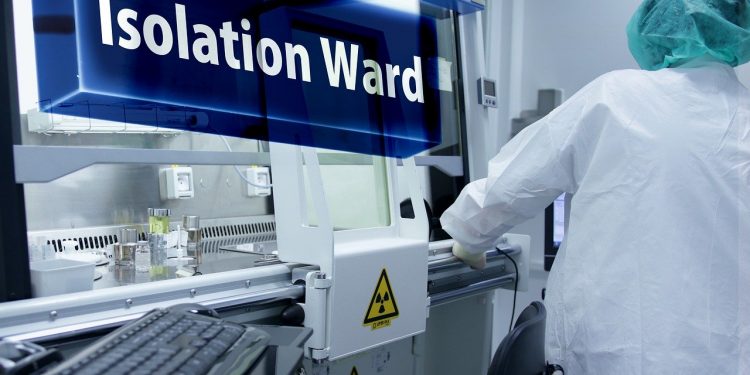More hospitals to receive and test patients for coronavirus

As the virus moves closer to home with the large outbreak in Italy, the Danish authorities have stepped up on the emergency management preparations and more are being tested. One case has been confirmed in Denmark.
The article continues below.
By Bente D. Knudsen
The risk assessment and guidelines for coronavirus COVID-19 in Denmark have been updated after a meeting last Monday within the European agency for the prevention and control of illnesses (ECDC) the Danish health authorities announce in a press release.
The strategy in Denmark is still to identify those who have been taken ill with the virus and their contacts, to isolate them as quickly as possible to prevent further spread but also to be ready should a situation arise where there are several who are ill and can spread the illness.
The Danish health authorities acknowledge that with the large outbreak in Italy the risk of spread to Denmark has increased and one case has been confirmed on Thursday the 27 February.
“With the spread of COVID-19 within Italy, we need to prepare for a scenario where there is a continued spread of the virus within Europe,” says Kåre Mølbak senior director at Statens Serum Insitut.
“We know now that most of those who are taken ill with the new coronavirus only have mild symptoms upon which the illness passes on its own. Those at risk of a serious effect of the virus are the elderly and those who are especially at risk due to other illnesses or other immune deficiencies.”
Danish GP’s are currently receiving a large number of requests for test from people who have been on holiday in Italy, a popular skiing destination for Danes. Travel to the north of Italy has been included in the screening guideline sent out to GP’s which includes China, South Korea, Singapore, Iran and now Italy.
The current assessment of the Danish health authorities is that the risk of an imported travel-related case occurring in Denmark has risen from low to moderate, an assessment confirmed with the first case found on Thursday 27 February, a Dane who had been skiing in Italy with his family. His wife and children tested negative but his was positive.
They still assess that the risk of transmission within Denmark is low, as the Danish healthcare system is well equipped and well trained in handling both individuals suspected of being infected as well as individuals with a contagious disease.
The authorities in Denmark and also the other Nordic countries have emphasised the advantage of having a health and emergency management system used to close cooperation, coordination and contact.
Currently there is a close monitoring of the situation and coordination with hospitals, ambulance services and general practitioners.
Seven Danish military barracks have been asked to prepare for the eventuality of having to host a large number of people in quarantine should the virus have reached Denmark and be suspected of having spread to a larger number of individuals.
Do not touch your mouth, nose or eyes if you were not able to wash or disinfect your hands.
Avoid close contact with people who cough or sneeze or show other flu like symptoms.
The article continues below.
Patients who are under suspicion of being infected with the coronavirus will be transferred to six hospitals in Denmark to be tested and isolated awaiting test results.
Four hospitals have stepped up on their preparedness measures to join Hvidovre Hospital on Zealand and Skejby Hospital (Aarhus, Jutland), previously the only two Danish hospitals assigned to testing for COVID-19.
The six hospitals ready to receive patients suspected of being infected with COVID-19 are Rigshospitalet (Blegdamsvej), Hvidovre Hospital, Aarhus Universitetshospital (Skejby), Aalborg Universitetshospital (Syd), Sjællands Universitetshospital (Roskilde) and Odense Universitetshospital.
The article continues below.
Currently, the World Health Organization (WHO) describes COVID-19 as a virus which gives only mild symptoms in 80 percent of the cases, which therefore do not require hospitalisation or help from medical staff.
A total of 15 percent of the cases are described are being in need of hospitalisation and medical care, while five percent are taken critically ill needing hospitalisation at an intensive care unit. Critical illness is primarily seen among the elderly or people with pre-existing medical conditions who are in a weakened condition.
Statens Serum Institut (SSI) has put in place a 24/7 emergency operation, which can test for new coronavirus within a delay of four hours.
The article continues below.
It is well known from other species of coronavirus, e.g. SARS and MERS, that transmission can occur by close contact with sick individuals. Generally, transmission of these viruses occurs by the spread of droplets from sneezing or coughing or by direct contact (e.g. contaminated hands).
It is currently not established whether transmission can occur from asymptomatic individuals (if someone with a disease is asymptomatic, it means that they do not show any symptoms of the disease) but current evidence suggests that individuals with symptoms are the main cause of transmission.
It is estimated that the virus may survive up to 48 hours on surfaces.
Source: Sundhedsstyrelsen
The article continues below.

